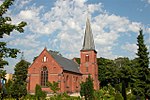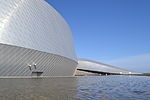Peberholm
Artificial islands of DenmarkTårnby MunicipalityØresundØresund Bridge

Peberholm (Danish pronunciation: [ˈpʰe̝wɐˌhʌlˀm] lit. 'Pepper Islet', Swedish: Pepparholm (Swedish pronunciation: [²pɛparˌhɔlm])), is a small artificial island in the Danish part of the Øresund strait, created as part of the Øresund Bridge connecting Denmark with Sweden. Peberholm lies approximately 1 km south of the small natural island of Saltholm (Salt Islet), and was named to complement it. It has an area of 1.3 km2 (320 acres) and belongs to Denmark.
Excerpt from the Wikipedia article Peberholm (License: CC BY-SA 3.0, Authors, Images).Peberholm
Øresundsmotorvejen, Tårnby Kommune
Geographical coordinates (GPS) Address External links Nearby Places Show on map
Geographical coordinates (GPS)
| Latitude | Longitude |
|---|---|
| N 55.6 ° | E 12.75 ° |
Address
Peberholm
Øresundsmotorvejen
Tårnby Kommune
Capital Region of Denmark, Denmark
Open on Google Maps










